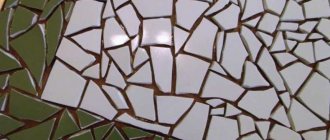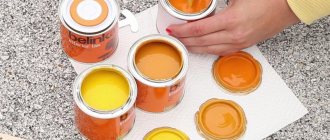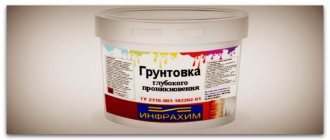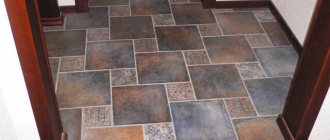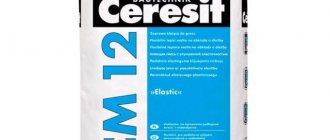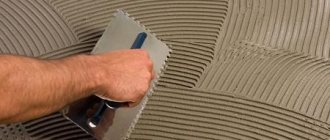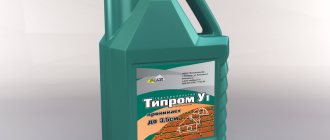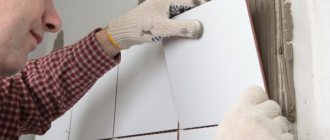Tile is often used for tiling a bathroom. The tile has the necessary properties for many years of operation in conditions of high humidity and frequent temperature changes. However, the cladding loses its decorative qualities over time. Using paint for ceramic tiles allows you to restore the former beauty of the cladding, but you need to choose the right material.
How to paint tiles: paint and brushes
To paint tiles in the bathroom, use enamel or auto enamel. This option is expensive, so it is used to update individual fragments of the cladding. The material fits well on the base and is characterized by abrasion resistance. In rooms with high humidity, you should not use water-dispersion-based compositions.
To choose a paint, the following material properties are taken into account:
- level of resistance to moisture and pollution;
- degree of washability;
- adhesion to the base;
- degree of surface coverage;
- color and safety for human health.
A decorative coating can also visually increase or decrease space and highlight the relief. The consistency of the material is similar to thick sour cream.
As for the tools for work, you will have to choose 2-3 types of brushes with long or short bristles. To get narrow lines you need a small tool. Wide brushes with long bristles are suitable for painting large areas.
Important! To create a matte finish you need a foam roller.
How to change the appearance of ceramic tiles without painting
Whatever materials you buy, in the “wet zone”, where there is frequent or constant water, the paint will peel off quickly. This is usually the wall near the bathroom. Painting ceramic tiles is not the best idea here. If you want to update the tiles, you can use self-adhesive film. Not the cheapest one, but the more expensive one - carbon. It is used for car tuning. It is denser, sticks and holds better.
If the grout between the seams does not look “good” or does not match the color, before gluing the film, remove the old grout and apply new one. Choose colors based on new colors. When the grout is dry, remove the residue and wash it. Then you can start updating the tiles.
Here is the result of gluing self-adhesive tiles onto the tiles.
In this case, before updating the old tiles in the bathroom or on the kitchen backsplash, we wash them. We cut the film into squares or rectangles - according to the size of your tile. It looks better if the edge of the tile is visible, but this is a matter of taste.
Before gluing the film, degrease the tiles and dry them. Then you can glue. The gluing technique is simple:
- Remove the protective film on the corner and fold it down.
- Glue the corner exactly to the tile. The protective paper is placed between the film and the wall.
- Pull the protective film, releasing a few centimeters of the adhesive layer.
- Use a rubber or plastic spatula to move forward/backward, gluing the film. We try not to let air get under the film. To do this, we are moving gradually, not in a hurry.
There are not many ways to update the tiles in the kitchen or bathroom: painting and gluing vinyl or carbon film. That's probably all
Actually, that's all. Let's move on to the next fragment. Nothing complicated, the surfaces are small. If the tiles have a relief, you will also need a hairdryer. If there is a construction one, great. No, a regular one will do. We set the construction shop to the minimum temperature, the hairdresser to the maximum. We start gluing from the flat part. Next, we heat the film, stretch it a little and glue it to the relief. Don't pull too hard. It becomes elastic. You can start by practicing.
What color should I paint the tiles?
Before painting ceramic tiles, choose a suitable finishing color, as it directly affects the interior. Bright shades can highlight some of the imperfections of the cladding, so it is better to avoid them. The bathroom uses neutral shades that blend with the furniture façade or untiled walls.
If you want to make an accent, then stencils or templates are used, as well as bright paint. It is allowed to use decorative panels with marine elements. To create the background, a white composition is used.
Floor tiles
Since tiles on the floor are subject to more use than other surfaces, they lose their appearance faster. Of course, it can serve for a very long time, but the abrasions begin to bother you. If you are faced with a similar problem, it's time to act.
For example, there is a tiled floor like this:
We picked up an original stencil and decided to paint the floor white and black.
Necessary materials:
- Floor cleaner
- Paint (white and black)
- Stencil
- Brush
- Masking tape
- Roller
- Paint tray
- Oil-based polyurethane
Composition selection
Before painting ceramics, you need to choose the right composition. The following types of paints are used to decorate bathroom walls:
- Acrylic. These are the optimal compositions for ceramic tiles. They are not afraid of exposure to moisture, do not wash out, and are harmless to human health, as they do not contain toxic substances. Such products contain antiseptic components, so fungus and mold do not develop in the bathroom. Acrylic paint comes in different colors, glossy and matte.
- Oily. This is a cheap finishing option that can be applied using a sprayer, brush or roller. It takes more than a day for the layer to dry. Oil paint is rarely used to decorate a bathroom. Despite the color variety, such products are not resistant to moisture and will crack over time. The surface should not be washed with soda solution.
- Alkyd. Such compositions dry quickly, do not crack, and are cheap. They are moisture resistant, give a matte or glossy surface, and are not damaged when exposed to detergents. The layer after application performs a decorative function for 4 years and is not afraid of temperature changes. By adding rosin, the product is used to color floor tiles.
- Epoxy . Of all the bathroom paints, they are characterized by maximum durability and are not afraid of moisture. Decorative qualities last 4-5 years. You can wash the surface using any means.
In addition to these compositions, silicone, silicate and latex paints are used for finishing tiles. The first option does not lose its properties when exposed to moisture and does not have a pungent odor. Silicate compounds repel water and do not become dirty, but their color palette is not rich. Silicone paints are vapor permeable, are not afraid of temperature changes, and are able to hide small surface defects due to the elasticity of the coating.
Is it possible to paint tiles?
Of course it is possible, several decades ago, this repair option was very popular, since getting good tiles was problematic. It is important to choose the right paint - this determines how long the coating layer will last.
Bathroom design with tiles
In fact, there are a lot of options - these include alkyd and acrylic paints. Although practice shows that oil enamels are best suited for painting ceramics. When choosing, it is also worth considering where the painting will be done. If these are walls in a corridor, then almost any enamel will do; no load will be applied to it. It's another matter when you need to restore floors or ceramics in the bathroom.
Important! When choosing enamel, you should buy one that is specifically designed for painting tiles.
In this case, the tile will be exposed to increased humidity and steam, therefore, it is desirable that the enamel is resistant to such influences. After all, porcelain tiles painted in the mass are initially made from the composition of the desired color, and when an additional layer of enamel is applied to it, it will no longer be so durable.
One of the best solutions can be a special paint for floors - it is very resistant to abrasion and has excellent adhesion to tiles. However, it is better to immediately abandon industrial options. They can be toxic, so it's best not to use them in residential areas.
Painting ceramics
Preparatory stage
If the choice of which paint to cover the tiles has been made, then the surface is prepared before applying it. The procedure includes the following steps:
- cleaning the base from lime or rust deposits, dust and dirt, splashes of water (use an acidic detergent or abrasive powder);
- surface treatment with clean water to remove residual soap solution;
- degreasing the tiles with gasoline or acetone (this is done after the tiles are completely dry);
- treating the base with sandpaper (this improves the adhesion of the paint to the surface);
- removing dust using a vacuum cleaner or a cloth;
- applying primer and puttying joints.
When cleaning tiles, special attention is paid to the seams between the tiles, because dirt accumulates most of all there.
Where is painting allowed?
Not all bathroom surfaces are allowed to be painted. You should not use this type of finish in places that will be in constant contact with water: the ceiling, flooring, walls in the shower stall. Even durable paint in such conditions begins to crack, fade and lose its decorative effect.
Required Tools
After the types of paints for the bathroom , the tools are prepared. The following equipment is required for operation:
- foam rubber sponge, dry rags;
- a set of paint brushes, a short-hair roller;
- paint tray;
- stationery knife, masking tape;
- protective film;
- fine-grain sandpaper;
- stencils.
The paint is pre-mixed. Protective clothing, goggles and a respirator are also required.
Features of composition selection
If the tiles must shine, then it is better to choose glossy types of compositions. Satin paints are used for a semi-matte surface with a velvety effect. Water drops or streaks are not visible on such a surface.
Choosing paint for work
There are two options for painting a tiled surface:
- Full coloring.
- Fragmentary restoration, which, in turn, is divided:
So, for each of the options, a different type of paint is selected. For complete coloring use:
To create an original decor with your own hands, you can do without completely painting the room, but paint it instead. For this purpose, special paints for glass and ceramics are used; their use does not require grinding the base when preparing the surface. True, such paints have a significant drawback: high price.
You can paint tiles with your own hands in the following ways:
Painting kitchen tiles
Particular attention is paid to the choice of paint for tiles, since the kitchen area is used in difficult conditions. The walls serve as a backdrop for the furniture. If you need to update your interior, painting is the easiest way to change the shade.
Defining boundaries
Before applying the first coat of paint, the size and geometric shape of the area it should cover is determined. Do not use the product in places where steam accumulates. Here the composition is applied around the perimeter or a border is made. In this way, the problem area is fenced off and adjacent ceramic elements are highlighted.
Preparing the base
The coloring composition will adhere well if the surface is prepared. The tiles are cleaned of dust, grease and dirt. Increased attention is paid to the seams between the tiles. For washing, use a soap solution or a specialized product.
If it is cracked, it is better to remove the grout in the seams and fill them with cement fugue. Excess material is removed. After filling the joints, the tiles must be washed again. If you cannot remove grease and dirt with a soap solution, you can use a scraper and abrasive powder. To remove slippery deposits, a mixture of ammonia and water is used. The components are taken in equal proportions.
Surface priming
If the entire surface of the wall is subject to repair, then it is pre-treated with fine-grained sandpaper. Large areas are difficult to clean in this way, so in this case it is better to use a primer. It will improve the adhesion of the composition to the base. To work, you will need a special substance designed for smooth surfaces: tiles, plastic or glass.
The primer will not only improve adhesion, but also cope with small chips and shallow cracks. The tiles can be painted once they are dry. This requires from 1 to 24 hours.
Features of paint application
Painting tiles is no different from treating other surfaces. To protect those parts of the walls on which the composition will not be applied, masking tape is used. Stencils are used to apply the design. They are also secured with tape. Using templates, you can create an apron or the perimeter of the room in the center
The edges of the stencils are pressed tightly against the tile, otherwise the paint will flow and the design will not turn out neat. Small brushes are used to decorate individual cladding elements. The strokes are applied evenly.
Color of tile joints
It is easier to paint the seams between tiles on the floor or wall in the same color as the entire surface. To create contrast you need a thin brush. The seams are covered with masking tape, after which the base shade is applied to the entire tile. After the paint has dried, the tape is removed and glued to the tile. The seams are now being processed.
The color can be contrasting: white with black, black with yellow. Similar shades from the same palette are suitable: brown with beige, azure with blue.
How to protect the coating
To make the new cladding last longer, the painted surface is treated with a water-based urethane varnish. This layer not only protects the walls from the influence of negative factors, but also fixes the pattern. The base should be varnished after the last layer of paint has dried. This takes 3-4 days.
When using a brush, the varnish is applied in 2 layers, if a roller is used, then in 1. Protection is required if the floor is painted or the tiles are lined with an oil composition. Before using the varnish, its compatibility with the paint is checked. To do this, a test sample is made on a piece of glass or plywood.
How to make a picture on tiles
If you have artistic talent, a panel containing plant elements, a still life, is depicted on the kitchen wall. First, the place that will be allocated for the painting is determined. The tiles are pre-treated with acetone to remove the fat layer, as well as with fine-grained sandpaper.
A pencil is used to draw the outlines of the drawing. Next, they are outlined with a thin brush. Oil-based paint will help here. Inside, the drawing is applied with an acrylic compound half an hour after the outline has dried. To prevent the paint from spreading and going beyond the outlined limits, apply it pointwise. The brush is held perpendicular to the base.
Features of operation
Painted tiles require special care. Since steam often accumulates in the kitchen, the humidity level increases, temperature changes occur, the paint layer becomes dull and loses its decorative qualities. Epoxy paint will crack if exposed to direct UV rays. Oil compositions do not tolerate frequent and prolonged contact with liquid. Do not wash the painting, ornament or picture on the tile with abrasive powders or metal scrapers. To ensure that the pattern remains bright, no acid-containing substances are used for cleaning.
Design Variations
Today, there are quite a few options for painting porcelain tiles. Depending on the intended design and your own imagination, you can bring to life the most daring and original ideas. There are several types of painting:
- Major – complete replacement of the color palette, images and other patterns.
- Revitalizing colors - without wanting to change the overall picture, the shade of the walls and floor can be refreshed and made more saturated. In this case, restoration of individual fragments of the design is possible.
- Formation of patterns - decoration with an ornament can be carried out both over the entire surface, and individual tiled elements can be highlighted in fragments.
- Drawings - can be made both on the walls and on the floor covering. Non-bulky images will give the room a special charm. Stencils can also be used.
- Images – painting tiles allows you to bring almost any design to life.
If you're happy with your bathroom and just want to add a few new details, you can use waterproof vinyl stickers, which come in a wide variety.
Painted tiles should not be exposed to excessive water or prolonged heat. When using compositions for coloring and painting, it is worth remembering that they cannot be washed with abrasive agents or rubbed with a hard brush.
How to paint tiles correctly (2 videos)
Paint from different manufacturers and types (20 photos)
Decor secrets
Using paint you can create an individual design. Drawings with a 3D effect are popular.
How to make a 3D effect
To create a three-dimensional relief, use gauze. Figures of the required size and shape are cut out of it and fixed on the surface of the base. Now the first layer of coloring composition is applied. After it dries, the fabric fragments are treated with enamel of the desired color. For this, a rough roller is used.
Secrets to preserving the durability of a drawing
To preserve the original appearance of the illustration, you need to wait for it to dry completely. This will take 3 days. Now the base is coated with a transparent water-based epoxy varnish. Oil-based polyurethane is also suitable. The varnish is applied in several layers. However, when using it, compatibility with the main finishing material is checked.
Examples in the interior
Today you can choose many options for painting ceramic tiles in the kitchen. The design of each tile fragment in two contrasting colors looks good. One of them may be white. The opposite corners are painted over.
If a drawing is supposed to be on the wall, then it is placed around the entire perimeter or an emphasis is placed on a certain part of the wall. You can also decorate individual tile fragments. A floral or geometric continuous pattern is often applied along the perimeter.
Decorating tiles with paint is the best option if there is no desire or need to completely change the ceramic layer. Anyone can cope with the procedure, even those without artistic talent. You just need to choose a design option, a suitable composition and follow the application technology.
Suitable paint types
When applying regular paint, after a while the coating will begin to peel and flake off. There are several types of tile paint that are mainly used to update old coatings:
- Latex - has excellent adhesive properties. For dry rooms, you should choose acrylic-latex compounds; for waterproofing purposes, rubber paints are suitable. The coating has a high level of wear resistance and waterproofing, is odorless and absolutely harmless to health.
- Epoxy is a more expensive option. Good adhesion, waterproof. The paint is firmly bonded to the coating and does not peel off over time.
- Oil-based is also suitable, but requires the application of a primer.
- Alkyd enamels have good adhesion and are used only in dry rooms.
- Stained glass for glass and tiles - applied to a smooth, cleaned surface, without preliminary preparation. Having a high cost, it is used mainly for decorative purposes to create a beautiful design.
- Polyurethane – resistant to temperature changes and humidity, does not peel off and is wear-resistant.
The primer for applying epoxy and polyurethane enamels must be based on organic solvents. Water-based primer is not suitable in this case.
In the video: using stained glass paints to cover tiles.
Interesting facts about chalk paint
Many manufacturers write on packages of chalk paint: “The material can be used without prior surface preparation.” In reality and in practice, the information is not entirely correct.
You can achieve your goals with careful preparation of the foundation. Cleaning and degreasing surfaces helps to get better results.
Surface preparation allows you to find imperfections in the form of dents, unevenness and other problems. Puttying and leveling makes them invisible, and further work with paint is of high quality.
How ideal the effect of aging or abrasion of furniture will be depends on the degree of wear of the product and the type of previous coating. If the first attempt does not produce a satisfactory effect, re-coat should be applied. As a rule, it gives positive results.
The need to paint tiles
Although this way of decorating a room comes to mind, in fact, many do not know for sure whether it is possible to paint tiles in the kitchen. This method is really not very common. Therefore, it is worth noting especially in what cases there may be a need for such an emergency mini-repair of kitchen ceramics.
- Updating the kitchen space from an aesthetic point of view. The painting method is the most elementary and least expensive of all, so it is ideal for quickly transforming the kitchen, bathroom and any other room where it is needed. With this approach, it is possible to radically change the design of walls and floors without unnecessary hassle and dust;
- Change of furniture. Replacing furniture elements inevitably entails replacing wall and floor cladding. This option involves changing the color of the tiles according to the new design project;
- A change in the style direction in the interior entails a revision of all existing types of decoration. Including the appearance of ceramic tiles;
- The need to disguise tile defects. Painting individual sections of the tile allows you to hide small flaws in the coating that have arisen during its intensive use. Moreover, you can do this completely independently, you just need to be able to hold a brush in your hands and use paint;
- Applying decor to a tiled surface allows you to complement the design with some colorful patterns and even images.
You don’t need much to decide to paint your backsplash. The main thing is to gain creative inspiration and create your own masterpiece, albeit small, where a smooth ceramic surface will act as a canvas.
Examples in the interior
Sources:
- https://IzPlitki.com/uhod-i-remont/pokraska-kafelnoj-plitki.html
- https://pol-exp.com/kak-pokrasit-plitku-na-polu/
- https://www.ivd.ru/stroitelstvo-i-remont/otdelocnye-materialy/kak-pokrasit-plitku-v-vannoj-svoimi-rukami-instrukciya-v-3-etapa-45791
- https://MasteraVannoy.ru/plitka/mozhno-li-pokrasit-kafelnuyu-plitku.html
- https://strir.ru/vnutren-otdelka/pokraska/pokraska-keramicheskoy-plitki
- https://IzPlitki.com/posle-ukladki/kraska-dlya-keramicheskoj-plitki.html
- https://plitka33.ru/kraska-dlya-plitki-v-vannoj/
- https://kallibry.ru/kak-pokrasit-kafelnuyu-plitku/
- https://diz-kitchen.ru/%F0%9F%A4%A6%E2%80%8D%E2%99%82remont/pol/kak-pokrasit-keramicheskuyu-plitku-na-kuxne-svoimi-rukami.html
- https://GidPoKraske.ru/okrashivanie/vidy-pokraski/kraska-dlya-plitki.html
- https://plitkahelp.com/uhod/kak-pokrasit-kafelnuyu-plitku-na-kuhne
Surface preparation
Initially, the tiles are prepared for painting, since the final result depends on this process. The process is divided into stages:
- the tile is completely cleaned of old coating, dirt or dust;
- cleaning is carried out using a metal brush, with particular attention paid to the seams;
- if you plan to apply paint to the entire surface of a wall or floor, then it is advisable to use a grinding machine or sandpaper;
- after cleaning, the surface is degreased using appropriate compounds;
- if chips or scratches are detected, they are filled with primer;
- If traces of rust are found, they are removed with a special liquid, and then the yellow elements are cleaned off with sandpaper.
It is recommended to start direct painting one day after applying the primer.
Features of operation
Painted tiles require careful care. Since there is high humidity, steam, and temperature changes in the kitchen, the paint may fade over time and lose its properties:
- When direct sunlight hits the epoxy mixture, it cracks;
- The oil-based paint mixture does not tolerate frequent, prolonged contact with water;
- Paintings and patterns should not be washed with abrasive powder or a metal scraper;
- To preserve the brightness of the pattern, cleaning should not be carried out using substances containing acid.
Application of a protective layer
To ensure that the paintwork lasts as long as possible, it is protected with varnish. After the paint has dried, one or two layers of varnish are applied on top. It is good that the chemical basis of the materials is the same. So, if acrylic dye was used, the varnish should also be on acrylate.
The number of layers is determined from the manufacturer's recommendations. They are applied with a brush, or less often with a roller. For rooms where there is a risk of mold, additional treatment of the painted surface with an antiseptic is desirable. It can be purchased at any hardware store. Moreover, this must be done regularly.
We figured out how to paint bathroom tiles with your own hands. This is a simple procedure that will help you update your boring interior without much expense and very quickly. You can act radically: repaint the floor and walls of the bathroom, or you can only slightly change the design, adding a small ornament or panel.
Video - How to paint tiles
Video – Updating old tiles
Tools and materials
To prepare the surface and apply the paint evenly, you will need the following tools:
- Flat brush - needed for applying the color mixture to a large surface;
- Paneled brush – drawing patterns and painting narrow areas, joints, hard-to-reach places;
- Container for paint - you can use any jar or special tray;
- Stick for stirring the color mixture;
- A roller with a long or short handle - the application layer is thinner than when working with a brush. It can be made of foam rubber or with short pile, if you need to paint a large area, or with long pile for relief application of the dye;
- Fine-grained sandpaper for surface preparation;
- Stationery knife - for removing excess strokes;
- Regular and masking tape to obtain smooth borders;
- Protective film - instead of it, you can use large garbage bags to cover furniture and equipment;
- Stencils for drawing patterns;
- Special clothing, respirator, glasses.
In addition to paint, you will need an epoxy primer, degreaser, final coat varnish, and a soapy solution of any foaming product such as dishwashing detergent or an alcohol-based cleaner to remove dirt.
